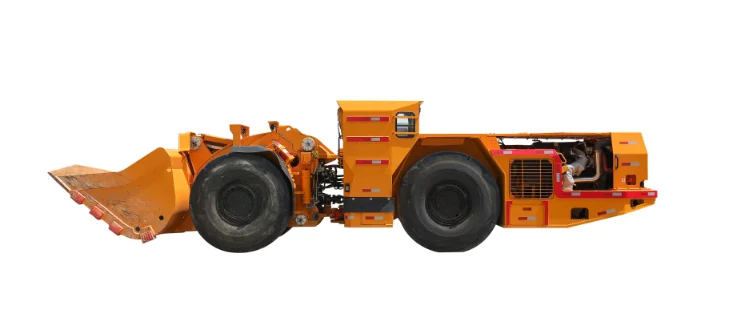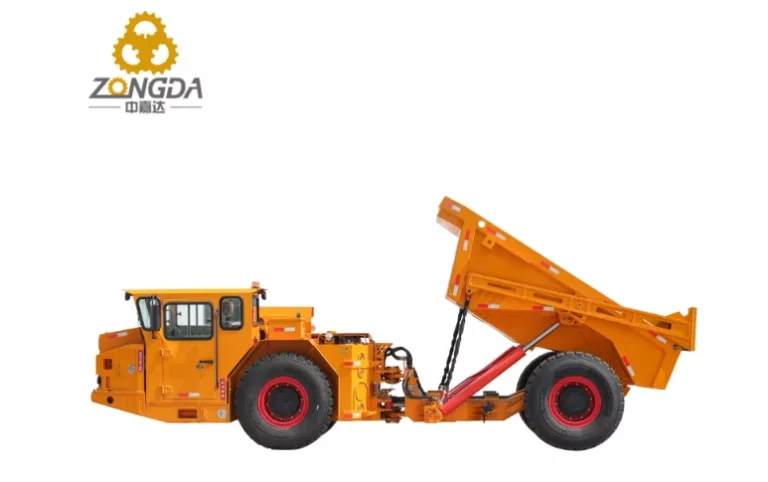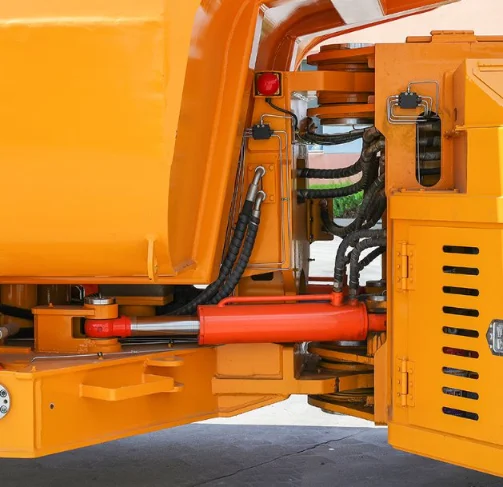
Underground hauling is supposed to be about tons per hour, not minutes lost per trip. Still, in many mines the load-haul-dump loop drags: the loader takes too long to fill, turning in the drift is slow, dumping at the pass needs two or three moves, then the machine crawls back out of the heading for the next round. Every delay pushes cost up and production down. You move less ore with the same crew and the same fuel. This is why mines now judge gear by what it does for cycle time, not just by capacity on paper. A modern underground mining loader is not only a bucket and four tires. Frame height, breakout force, steering angle, dump angle, braking feel, service access — those choices decide how fast the loop turns in real headings.
Why Are Load-Haul-Dump Cycles Taking Too Long?
You usually know the loop is slow before you time it. Trucks sit waiting on ore. Operators complain that the heading is too tight. Supervisors keep saying “one more minute.” The cause is rarely one big issue. It is a stack of little drags: slow fill, too much steering to get lined up, inching down grades because brakes feel jumpy, messy dump that needs a second correction, then a long tram distance back. All of that lands on your load haul dump cycle time. Cut 20 seconds off one round and the end-of-shift total can change by several extra buckets.
Narrow Tunnels, Tight Turns and Low Overhead
Your headings are usually low and narrow, with vent ducting, cables, maybe water in the floor. You cannot drive like it is surface. If a loader has a wide body, long wheelbase, or weak steering angle, it needs extra space to position under the face. That positioning time is pure loss. A compact low-profile loader that sits lower and turns tighter gets in, fills, and backs out faster because it is built for that restricted geometry. You notice this a lot when two units are sharing one drift and every hesitation becomes a traffic jam.
Long Tramming Distances and Unoptimized Load Points
Cycle time stretches as tram distance stretches. If the run from loading point to dump point gets longer and there is only one dump location so everyone queues there, production sags. You cannot always shorten the tunnel, but you can cut wasted motion inside that distance. A loader that carries a higher fill each trip, tracks steady on ramps instead of riding the service brake, and backs into the pass in one smooth move will lift tons per hour. That means less empty travel and fewer awkward reverses in tight spots.
Poor Loading and Dumping Efficiency
Loading and dumping should be quick. Often, they are not. Weak breakout force or poor bucket shape forces the operator to “nibble” the muck pile instead of taking a confident bite. That means more scoops and more spill. At the dump point, a slow lift or shallow dump angle turns what should be a quick unload into a shake-and-wait routine. Each hesitation is only seconds, but those seconds happen every single loop.
How Vehicle Design Can Shorten Each Cycle?
You can adjust blasting, repaint traffic routes, coach operators. All useful. But core machine design is the lever that never clocks out. The way the loader is built decides how fast it moves in real underground conditions, not just in a sales photo. A purpose-built underground mining loader directly attacks the bottlenecks that slow you down.
Compact Low-Profile Design for Underground Trams
Profile height is more than “does it hit the back.” A true compact low-profile loader rides low, keeps mass low, and fits headings without scraping roof or ducting. Lower profile and a tighter turning radius mean fewer steering corrections to line up on the muck pile and fewer corrections to exit. That clean in-and-out motion repeats all day. Over a twelve hour shift, repeatable movement is free productivity.
High Breakout Force and Bucket Geometry
Fast fill is money. Breakout force and bucket geometry decide how quickly you can fill to a useful factor instead of dragging half a scoop. A good bucket enters the muck pile, curls, locks material, and leaves without dropping half of it back on the floor. Better fill per scoop means fewer scoops per round, which cuts total face time. A clean dump angle that tips material fast at the ore pass also saves seconds, and seconds add up.
Optimized Haul and Dump Systems
Once the bucket is full, now you have to tram loaded, often down a grade. Stability and braking become both safety and speed. When the operator trusts how the machine brakes on wet ramps, the machine can hold consistent travel speed instead of creeping. When the frame stays planted instead of bouncing, the operator is not riding the pedal out of fear the load will shift. Confident downhill control means faster return to the heading. At the dump point, a fast lift, decisive tip angle, and clear drop mean the loader can empty and go without rocking back and forth.
What Metrics Should You Track to Measure Cycle Improvement?
You cannot fix what you do not measure. A lot of operations still run on gut feel, which sounds old-fashioned but happens all the time. You get much better results when you track a few basic numbers shift after shift and treat them like you treat tons on the mill.
Cycle Time Per Trip
The core number is total loop time, from first engagement with the pile, to tram, to dump, to return to the face. That is your true load haul dump cycle time. If this number rises through the night shift, fatigue is hitting you. If it spikes on certain headings, layout is hurting you. If it jumps after minor damage to the loader, condition is the problem. You do not need fancy software to time a loop.
Tons Per Hour and Fill Factor
Tons per hour is cycle time plus how full each bucket actually is. A fast loader that hauls mostly air is not helping. Fill factor measures how close you are to practical capacity each scoop. If you can raise fill factor without slowing the loop, you get more ore per hour without adding another unit. That is often the cheapest productivity gain in the mine.
Machine Utilization and Availability
Availability also tells a story. You cannot haul ore with a parked machine. If the loader spends half the shift down for quick fixes, or cooling brakes, haul stops. A design with clean hose routing, logical service panels, and fast access to wear parts can be patched and sent back underground fast. That is where “serviceability” stops being a buzzword and becomes direct money.

Key Design Features to Look For When Selecting Your Underground Loader?
At purchase time you will hear numbers like horsepower and capacity. They matter, but they do not tell you if the loader will actually move in your headings, on your grades, with your people. You want design features that map to the real slowdown points you fight daily.
Size, Turning Radius and Undercarriage Clearance
Ask if the loader fits your lowest back height without scraping, and if it can still turn in your tightest crosscut without a three-point shuffle. Undercarriage clearance matters too. Water, rutted floor, loose muck — if the belly hangs up, the loop dies.
Breakout Force, Bucket Capacity and Dump Angle
Look at how fast the bucket fills, how well it holds, and how quickly it dumps at the pass. High breakout force, solid bucket shape, and a positive dump angle cut wasted scoops and wasted shake time.
Traction, Braking and Haulage Stability
You want steady downhill control on wet ramps and confident climb-out when loaded. The operator should not have to “feather and pray” on every descent. Stable braking and predictable steering are production tools and safety tools. This links straight to fatigue reduction in mining operations. If the operator is not tense every trip, the operator lasts longer in the seat with fewer mistakes.
Serviceability, Parts Access and Operator Comfort
A loader that is impossible to service will sit. Check access to major components and common wear parts. Ask how long basic fixes take. Cab comfort matters more than some managers admit. Clear sight lines, lower vibration, and decent seating position reduce stress on long shifts. Less stress leads to steadier driving, not jerky stop-go behavior that wastes seconds all night.
FAQ
Q1: Why does a slower cycle matter if ore is still moving?
A: Longer cycle time means fewer total trips per shift and lower total tons. You pay the same labor and get less hauled.
Q2: How does loader size affect output underground?
A: If the loader cannot turn or enter the pile cleanly, it wastes time lining up. A compact low-profile loader moves in tight space and gets back out sooner.
Q3: What is the fastest way to raise tons per hour without buying more units?
A: Improve fill factor and shorten dump time. Better bucket fill and faster empty at the pass usually give an immediate gain.
Q4: How does operator fatigue slow production?
A: Tired operators brake early, turn wide, and take longer to align at dump points. That stretch hits every trip in the loop.
Q5: Why should service access be part of the buying decision?
A: A loader that can be serviced quickly comes back into the heading quickly. If it sits waiting on a simple repair, your haul plan falls apart.
QINGDAO ZONGDA MACHINERY CO., LTD supplies loading and haulage equipment for metal ore mines, not coal mines. ZONGDA focuses on underground machines built for low backs, tight drifts, steep ramps, and long tram distances. The range is designed around fast cycle speed, stable braking on grade, strong bucket fill, and operator protection. The goal is practical: move more ore per hour with less downtime and lower strain on the operator. Full product information, technical support, and direct contact are available through the official product lines and service channels listed on the company site.



